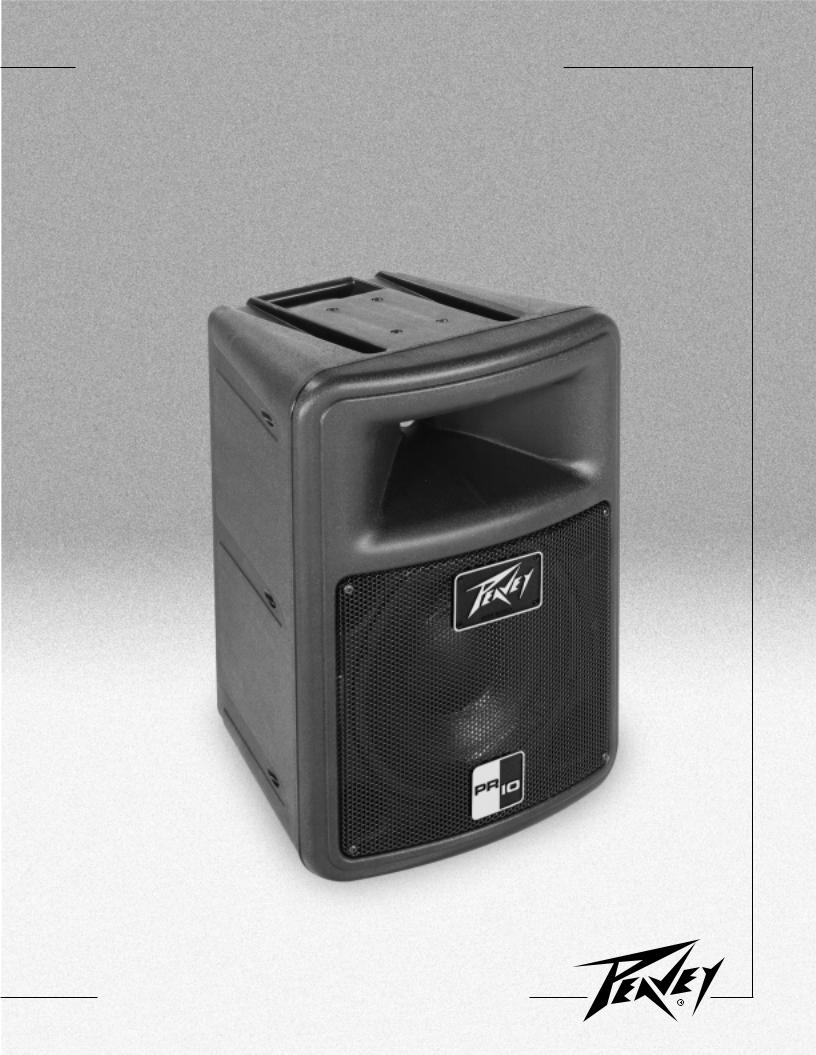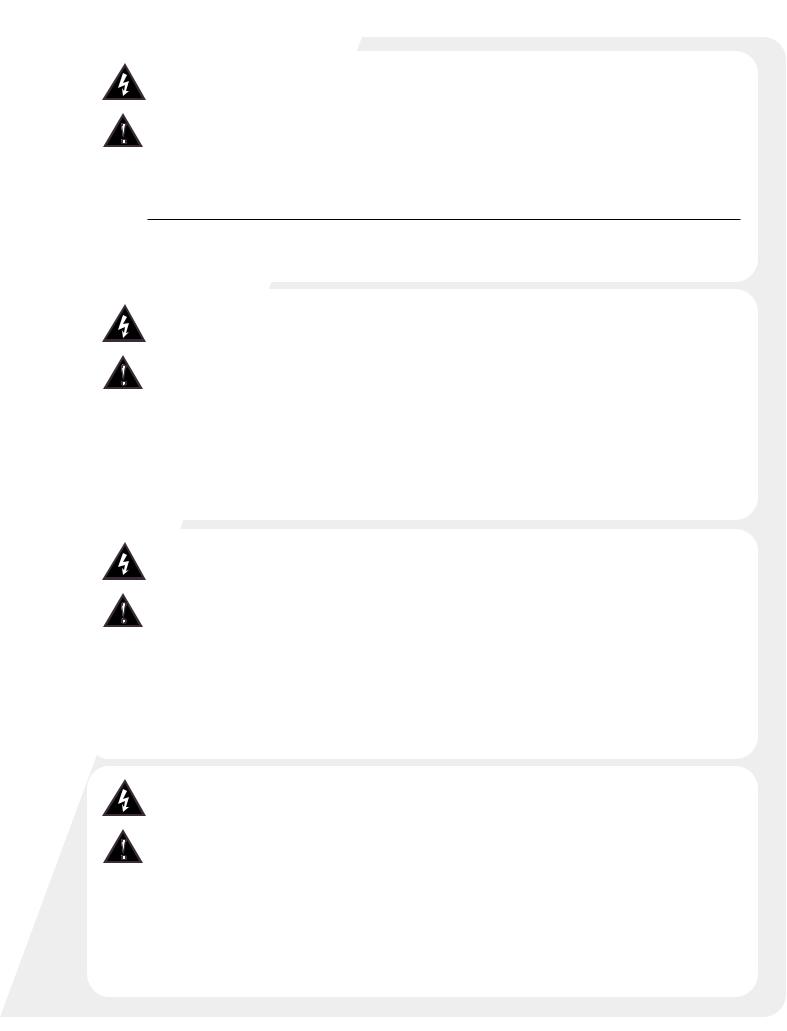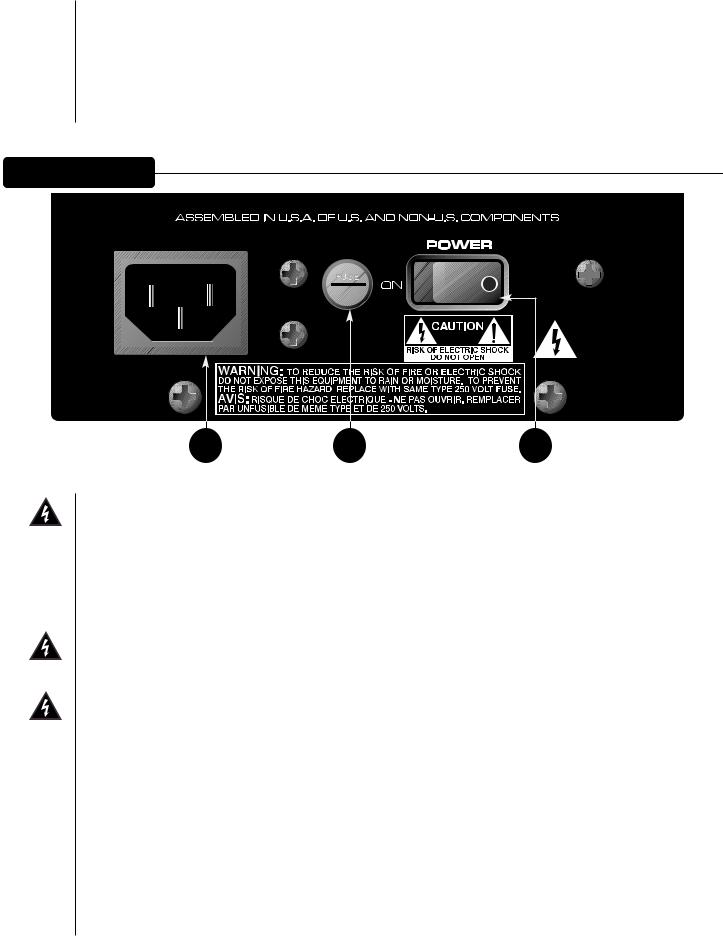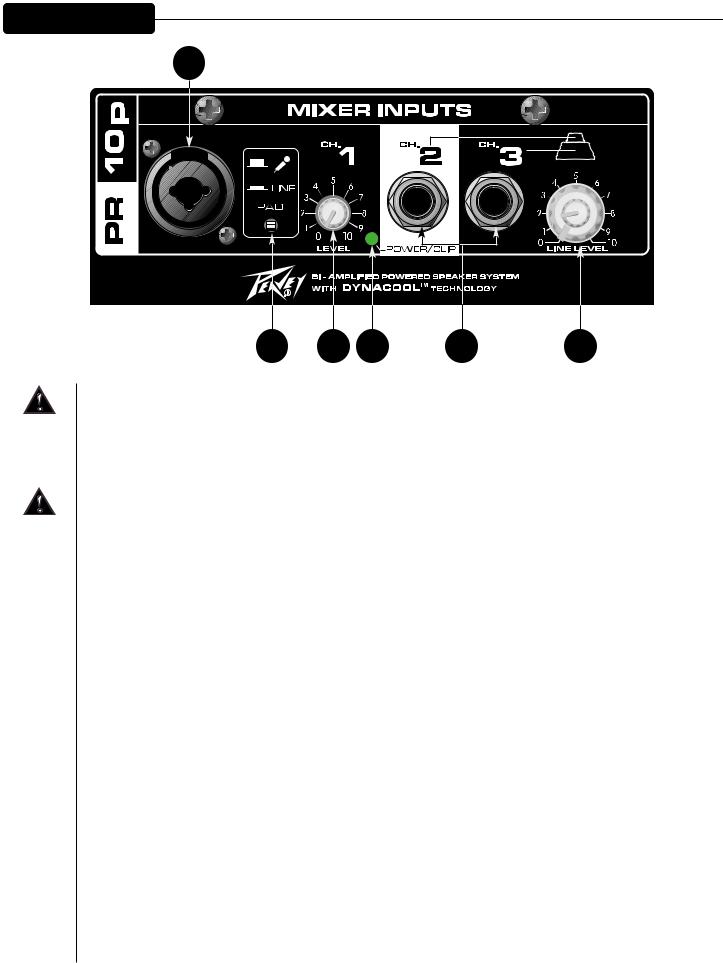Peavey PR 10P User Manual

PR™ 10P Powered bi-amplified two-way speaker system · Operations Manual
For more information on other great Peavey products, go to your local Peavey dealer or online at www.peavey.com.

Intended to alert the user to the presence of uninsulated “dangerous voltage” within the product’s enclosure that may be of sufficient magnitude to constitute a risk of electric shock to persons.
Intended to alert the user of the presence of important operating and maintenance (servicing) instructions in the literature accompanying the product.
CAUTION: Risk of electrical shock — DO NOT OPEN!
CAUTION: To reduce the risk of electric shock, do not remove cover. No user serviceable parts inside. Refer servicing to qualified service personnel.
WARNING: To prevent electrical shock or fire hazard, do not expose this appliance to rain or moisture. Before using this appliance, read the operating guide for further warnings.
Este símbolo tiene el propósito, de alertar al usuario de la presencia de “(voltaje) peligroso” sin aislamiento dentro de la caja del producto y que puede tener una magnitud suficiente como para constituir riesgo de descarga eléctrica.
Este símbolo tiene el propósito de alertar al usario de la presencia de instruccones importantes sobre la operación y mantenimiento en la información que viene con el producto.
PRECAUCION: Riesgo de descarga eléctrica ¡NO ABRIR!
PRECAUCION: Para disminuír el riesgo de descarga eléctrica, no abra la cubierta. No hay piezas útiles dentro. Deje todo mantenimiento en manos del personal técnico cualificado.
ADVERTENCIA: Para evitar descargas eléctricas o peligro de incendio, no deje expuesto a la lluvia o humedad este aparato Antes de usar este aparato, Iea más advertencias en la guía de operación.
Ce symbole est utilisé dans ce manuel pour indiquer à l’utilisateur la présence d’une tension dangereuse pouvant être d’amplitude suffisante pour constituer un risque de choc électrique.
Ce symbole est utilisé dans ce manuel pour indiquer à l’utilisateur qu’il ou qu’elle trouvera d’importantes instructions concernant l’utilisation et l’entretien de l’appareil dans le paragraphe signalé.
ATTENTION: Risques de choc électrique — NE PAS OUVRIR!
ATTENTION: Afin de réduire le risque de choc électrique, ne pas enlever le couvercle. Il ne se trouve à l’intérieur aucune pièce pouvant être reparée par l’utilisateur. Confiez I’entretien et la réparation de l’appareil à un réparateur Peavey agréé.
AVERTISSEMENT: Afin de prévenir les risques de décharge électrique ou de feu, n’exposez pas cet appareil à la pluie ou à l’humidité. Avant d’utiliser cet appareil, lisez attentivement les avertissements supplémentaires de ce manuel.
Dieses Symbol soll den Anwender vor unisolierten gefährlichen Spannungen innerhalb des Gehäuses warnen, die von Ausreichender Stärke sind, um einen elektrischen Schlag verursachen zu können.
Dieses Symbol soll den Benutzer auf wichtige Instruktionen in der Bedienungsanleitung aufmerksam machen, die Handhabung und Wartung des Produkts betreffen.
VORSICHT: Risiko — Elektrischer Schlag! Nicht öffnen!
VORSICHT: Um das Risiko eines elektrischen Schlages zu vermeiden, nicht die Abdeckung enfernen. Es befinden sich keine Teile darin, die vom Anwender repariert werden könnten. Reparaturen nur von qualifiziertem Fachpersonal durchführen lassen.
ACHTUNG: Um einen elektrischen Schlag oder Feuergefahr zu vermeiden, sollte dieses Gerät nicht dem Regen oder Feuchtigkeit ausgesetzt werden. Vor Inbetriebnahme unbedingt die Bedienungsanleitung lesen.

IMPORTANT SAFETY INSTRUCTIONS
WARNING: When using electrical products, basic cautions should always be followed, including the following:
1.Read these instructions.
2.Keep these instructions.
3.Heed all warnings.
4.Follow all instructions.
5.Do not use this apparatus near water.
6.Clean only with a dry cloth.
7.Do not block any of the ventilation openings. Install in accordance with manufacturer’s instructions.
8.Do not install near any heat sources such as radiators, heat registers, stoves or other apparatus (including amplifiers) that produce heat.
9.Do not defeat the safety purpose of the polarized or grounding-type plug. A polarized plug has two blades with one wider than the other. A grounding type plug has two blades and a third grounding plug. The wide blade or third prong is provided for your safety. If the provided plug does not fit into your outlet, consult an electrician for replacement of the obsolete outlet.
10.Protect the power cord from being walked on or pinched, particularly at plugs, convenience receptacles, and the point they exit from the apparatus.
11.Note for UK only: If the colors of the wires in the mains lead of this unit do not correspond with the terminals in your plug‚ proceed as follows:
a)The wire that is colored green and yellow must be connected to the terminal that is marked by the letter E‚ the earth symbol‚ colored green or colored green and yellow.
b)The wire that is colored blue must be connected to the terminal that is marked with the letter N or the color black.
c)The wire that is colored brown must be connected to the terminal that is marked with the letter L or the color red.
12.Only use attachments/accessories provided by the manufacturer.
13.Use only with a cart, stand, tripod, bracket, or table specified by the manufacturer, or sold with the apparatus. When a
cart is used, use caution when moving the cart/apparatus combination to avoid injury from tip-over.
14.Unplug this apparatus during lightning storms or when unused for long periods of time.
15.Refer all servicing to qualified service personnel. Servicing is required when the apparatus has been damaged in any way, such as power-supply cord or plug is damaged, liquid has been spilled or objects have fallen into the apparatus, the apparatus has been exposed to rain or moisture, does not operate normally, or has been dropped.
16.Never break off the ground pin. Write for our free booklet “Shock Hazard and Grounding.” Connect only to a power supply of the type marked on the unit adjacent to the power supply cord.
17.If this product is to be mounted in an equipment rack, rear support should be provided.
18.Exposure to extremely high noise levels may cause a permanent hearing loss. Individuals vary considerably in susceptibility to noise-induced hearing loss, but nearly everyone will lose some hearing if exposed to sufficiently intense noise for a sufficient time. The U.S. Government’s Occupational Safety and Health Administration (OSHA) has specified the following permissible noise level exposures:
Duration Per Day In Hours |
Sound Level dBA, Slow Response |
8 |
90 |
6 |
92 |
4 |
95 |
3 |
97 |
2 |
100 |
1 1⁄2 |
102 |
1 |
105 |
1⁄2 |
110 |
1⁄4 or less |
115 |
According to OSHA, any exposure in excess of the above permissible limits could result in some hearing loss. Ear plugs or protectors to the ear canals or over the ears must be worn when operating this amplification system in order to prevent a permanent hearing loss, if exposure is in excess of the limits as set forth above. To ensure against potentially dangerous exposure to high sound pressure levels, it is recommended that all persons exposed to equipment capable of producing high sound pressure levels such as this amplification system be protected by hearing protectors while this unit is in operation.
SAVE THESE INSTRUCTIONS!

PR™ 10P
Thank you for purchasing the powered section that provides 200 Watts peak compression driver tweeter, both with RX™14 compression driver, the PR 10P balanced input with volume control and a line-level input signals can be mixed
It is very important that you ensure the PR for your PR 10P printed next to the IEC line ensure your personal safety as well as the
Features
·Bi-amplified powered system with 270 W tot
·Both power amps have DDT compression
·10" heavy duty woofer with 2" voice coil and
·RX 14 1.4" titanium compression driver
·Peak SPL up to 119 dB with music!
·Combo jack with 1/4" TRS and Female XLR
·Two 1/4" phone jack inputs with concentric l
·Input mixing built-in
·Molded-in horn with exceptionally smooth r
·Top handgrip molded in
·Pole mount molded-in
·Top and bottom flying point inserts
Description
The Peavey PR 10P is a powered, biperformance in a compact, powered of sound. The enclosure utilizes tough grille to offer an attractive-yet-durable
This two-way powered system is comprised The RX™14 compression driver is driven by a coupled to an extremely smooth and wellis molded integrally into the enclosure.
A balanced input to the preamp/EQ switchable between mic-level and line-level pair of level controls. All three inputs can be
The power amplifiers providing the binominal 8 Ohm load of the woofer, and a 50 selected for their reliability and superb compression, which virtually eliminates
A molded-in handle provides ease of Versamount™ allow maximum utility.
ENGLISH
The PR 10P features a bi-amped power Watts peak dynamic power for the Offering a 10" heavy duty woofer and the
jack, with mic/line switchable level, concentric volume controls. Up to three level signals mixed.
supplied. You can find the proper voltage the unit. Please read this guide carefully to
engineered to provide the highest levels of
k SPL, this tiny system can pump out a lot plastic trapezoidal form with a coated steel
amplifier driving a 10" heavy duty woofer. and features a 1.4" titanium diaphragm
(with a coverage pattern of 90˚ by 40˚) that
XLR and 1/4" TRS phone jack. It is
inputs are controlled in level by a concentric
providing 150 W continuous RMS into the 8 Ohm load of the tweeter. They were
amplifiers feature our patented DDT™
(top and bottom) for the Peavey
4

Applications
The Peavey PR™10P has a variety of applications such as sound reinforcement, public address, side fill system, karaoke or musical playback. With the optional monitor stand kit, the Peavey PR 10P makes an excellent stage monitor.
A typical signal source for the line-level inputs of the Peavey PR 10P would be a sound reinforcement mixing console (mixer) or the output from a CD player, Minidisc player or tape deck. A dynamic microphone can be connected and used as well.
R E A R P A N E L
2
(1) FUSE
The unit is AC power line fuse protected from overloads and fault conditions with an ABC-type fast-blow 5 Amp fuse. This fuse is located within the cap of the fuse holder. If the fuse fails, THE FUSE MUST BE REPLACED WITH THE SAME TYPE AND VALUE IN ORDER TO AVOID DAMAGE TO THE EQUIPMENT AND TO PREVENT VOIDING THE WARRANTY. If the unit repeatedly blows fuses, it should be taken to a qualified service center for repair.
(2) IEC POWER CORD CONNECTION
This receptacle is for the IEC line cord (supplied) that provides AC power to the unit.
Never break off the ground pin on any equipment. It is provided for your safety. If the outlet used does not have a ground pin, a suitable grounding adapter should be used and the third wire should be grounded properly. To prevent the risk of shock or fire hazard, always be sure that the mixer and all other associated equipment are properly grounded.
(3) ON-OFF SWITCH
This rocker switch supplies AC power to the PR 10P when switched to the ON position.
5

F R O N T P A N E L
5
6 7
(4) POWER/CLIP LED
Illuminates GREEN when the electronics receive when amplifier clipping is occurring or the
(5) PRIMARY INPUT (CHANNEL 1)
The primary input is switchable between line medium impedance balanced type, and when impedance. Jack (5) is a combo female XLR
(6) PAD
Switches the sensitivity of Channel 1 from sensitivity is set for line-level input signals, sensitivity is increased by 30 dB so it is suitable
(when the Power switch (3) is On). Illuminates RED tripped the thermal protection system.
and mic-level input. The line-level input is of the to mic-level it is of a typical low-Z mic input
TRS connector.
to mic-level sensitivity. Pushed all the way in, the the white tab is closer to the front panel, the
mic-level signals.
(7) VOLUME
Controls the gain (level) of the Primary Input |
1, of the powered speaker system. It is used to |
directly set the system output level for the Channel 1 input signal. |
|
(8) SECONDARY INPUTS, CHANNEL 2 &
These consist of 1/4" unbalanced phone jac line-level signals, with medium input impedance.
(9) CONCENTRIC VOLUME, CHANNEL 2
Controls the gain (level) of Channel 2 & 3 be used in conjunction with the Channel 1 volume control (7) to mix three line-level signals together, or two line-level signals and one mic-level signal.
6

O P E R A T I N G I N S T R U C T I O N S
CAUTIONS
The unit must be disconnected from the AC power source before any work is done on it. Refer all servicing to qualified service personnel.
The heat sink on the back plate can become hot to the touch. Do not block or cover the heat sink from ventilation.
Be sure to keep the microphone away from the front of the speaker after switching the mic sensitivity pad to the OUT position and while setting the microphone level or very loud feedback will occur! Damage to the system is likely if this occurs!
DO NOT connect the inputs of the PR™10P to the output of a power amplifier. The inputs are meant to be driven from a line-level strength signal.
DO NOT remove the protective metal grille.
Warning: The PR 10P is very efficient and powerful! This sound system can permanently damage hearing! Use extreme care setting the overall maximum loudness!
The apparent sound level of the PR 10P can be deceiving due to its clear, clean sound output. The lack of distortion or obvious distress can make the sound level seem much lower than it actually is. This system is capable of SPL in excess of 119 dB at 1 M from the speaker!
Flying the PR 10P
Caution: The suspending or flying of the Peavey PR 10P must be done by a certified structural engineer.
Important Safety Information for Mounting the Peavey PR 10P speaker system
Caution: Before attempting to suspend this model of speaker, consult a certified structural engineer. Speaker can fall due to improper suspension, resulting in serious injury and property damage. Other enclosures must not be suspended below one, nor should additional weight be suspended from one of these units. Use only the correct mating hardware. All associated rigging is the responsibility of others.
Always use all four inserts of a given group as a set, NEVER use just one insert to fly a cabinet! The four insert groupings are a top group of four and a bottom group of four. Some models also have a group of four on the rear plane of the cabinet.
Maximum enclosure angle from vertical hang: 30˚
Always use a suitable safety chain or wire rope, looped through the top handle, and firmly attached to a suitable structural member as indicated by a certified structural engineer.
The recommended range of torque for the mounting bolt is 3 to 3-1/2 lb./feet of torque. DO NOT OVERTIGHTEN! If an insert spins, it has been damaged and the cabinet can not be flown!
Never transport the cabinet while mounted on an array bracket or other mounting bracket, as this may unduly stress the mounting inserts.
WARNING! (note to structural engineer)
For the PR 10P, the thread insertion depth of the end of the mounting bolt should not be more than 5/16" past the surface of the cabinet.
If these thread insertion depths are exceeded, then the inserts may be damaged or unseated from the cabinet, severely compromising the mounting integrity of the cabinet!
The correct mounting bolt diameter and threads per inch are: 1/4" X 20. Use of a grade five-bolt is recommended.
7

Getting AC Power To The PR™10P
The PR 10P comes with an 8-foot IEC connection AC power cord. If you are using an extension cord or power strip with this powered speaker, make sure it is of good quality and of a sufficient current capacity to maintain safety and maximize the power output capability of the PR10P. Do not connect any other device to the same extension cord that the PR 10P is connected to.
Special Note for Permanent Installation
When installing the PR 10P, AC power runs will be used and a certified electrician should be consulted to be sure that all AC wiring complies with local codes and regulations. It is also advisable to use a cable clip properly affixed to the cabinet to strain relief the IEC power cord connected to the amplifier module at (2) so the power cord cannot be pulled out or vibrate loose.
Use of PR 10P with a Subwoofer
The built-in pole adapter allows use with the Peavey SP Subcompact 18X and the accessory pole that it is designed to use, Peavey part #00326540.
The pole used is 36 3/16" long and has a nominal diameter of 1 3/8".
Getting a Signal to the PR 10P
There are a variety of ways to input a signal to the PR 10P.
The primary input (5) provides either a balanced micor line-level input, allowing the use of a 1/4" phone plug, either a standard single-ended (tip-sleeve) plug or a balanced TRS (tip-ring-sleeve) type plug OR a male XLR plug. Then there are two line-level unbalanced 1/4" phone jacks that can be mixed in with the primary input.
Do not connect cables to the jacks while the unit is ON and the Volume is turned up!
While a standard single-ended 1/4" phone plug-equipped cable will work well, and the balanced input circuitry of the primary input (5) will provide some interference rejection, a balanced cable using either the balanced TRS 1/4" phone plug or the XLR plug will provide superior interference rejection and performance. Sometimes, with difficult interference problems, it will be helpful to lift the shield ground on a balanced cable at the PR 10P end only. Check any input changes carefully, always turning the volume control down before plugging and unplugging cables.
Use of high quality, premium cables is recommended for the PR 10P, as these usually have better shielding and materials and will provide greater long-term reliability. It is usually a good idea to leave some slack at the input to the PR 10P and also to tape the cables down or run them under a cable guard to avoid anyone tripping over them or pulling the PR 10P over when stand mounted.
Volume Control Adjustment
The PR 10P is equipped with a volume control to facilitate use in many different applications. With the volume control adjusted fully clockwise, gain is at maximum and the input sensitivity is 0.375 V RMS for full rated output. When driving the PR 10P from a mixer, it may be advantageous to reduce the input sensitivity by turning the volume control to the halfway point. The PR 10P will now more closely match a typical power amp.
If the mixing board indicates clipping of it’s output signals, then all of the PR 10P power capability is not being utilized cleanly. Clipping the signal before it gets to the PR 10P is not optimal. Reduce the mixer output level and turn up the volume control on the PR 10P.
The amplifiers in the PR 10P are equipped with DDT™ and an LED indicator to show that DDT™ has engaged. If the sound seems heavily compressed, check this indicator; and if it is blinking RED more than occasionally, then the drive level from the mixer (or the volume control on the PR 10P) needs to be reduced.
8

When first turning on the sound system, switch on all upstream electronics first, then the PR™10P with its volume control fully counter clockwise (all the way down). Begin checking levels with the mixer output level controls all the way down, and bring them up slowly with the PR 10P volume control set to the desired setting (halfway up recommended to start).
Mic/Line Pad Adjustment
The mic/line pad (6) provides for the increased gain needed for microphone use into the primary input (5). Use a straightened paperclip or small screwdriver to reach through the hole in the rear panel where the recessed tab is to set its position. Set the Mic/Line Pad to “in,” or the white tab furthest from the panel, for line-level signal use and set it “out,” or closest to the panel, for mic level use. The unit is shipped with the tab in the line-level position. It is recessed behind the panel so that the gain cannot be inadvertently increased during transport or set-up.
Due to the 30 dB of extra gain that this switch provides, DO NOT leave it in the “out” position for line-level use! This will result in input-stage clipping of the PR 10P and cause unnecessary distortion.
Mixing Signals Using the Volume Knobs
The gain of all three channels can be adjusted independently from the other channels via the volume knobs (7) and (9). Channel 1 can be used for either line-level signals or as a mic input and mixed with two other line-level signals.
The PR 10P has plenty of gain, so do not overload the speaker system preamp inputs by driving them with a signal that is too hot. Full output mixer levels well in excess of 0 dB will not be necessary to drive the unit to full power capacity.
TROUBLESHOOTING
No Output at All
First, make sure the unit has AC power and is turned on. Make sure the Power/Clip LED (4) is illuminated Green. If not, make certain the ON/OFF switch (3) is in the ON position and check the IEC power cord connection (2) by ensuring it is fully engaged and seated. Make certain the AC line cord is plugged into a working AC outlet.
Finally, check the fuse (1). (See the Rear Panel: Fuse section, for safety instructions.)
Once assured your unit is getting AC power, check that the PR 10P is getting a signal. Temporarily disconnect the cable running to the its inputs and connect it to some other device capable of reproducing the signal (i.e., a power amp and speaker). If this produces a signal, make sure that all Volume controls being used have been turned up to a satisfactory level (one-third to halfway).
If the PR 10P has been subjected to direct sunlight or excessive heat, the built-in thermal protection may have been triggered. The power/clip LED will be illuminated RED if this is the case. If so, turn off the PR 10P and let it cool for a sufficient amount of time.
If there is still no output, contact your authorized Peavey dealer or the Peavey International Service Center.
9

Hum or Buzz
If the PR™10P is producing a hum or buzz, this can be AC outlet related. Try plugging the PR 10P into a different AC outlet. Sometimes, if a different circuit (breaker) is used for the mixer and the PR 10P, it can cause hum problems.
Ensure that shielded cables have been used to route the signal to PR 10Ps inputs. If speaker cables with 1/4" plugs are used as input cables instead of shielded cables, it will be prone to hum or buzz.
Hum may be ground loop related. Try lifting the ground connection at the speaker end of the signal cable if it is a balanced signal cable. Check any input changes carefully by first turning down the volume control, plugging and unplugging cables, or lifting the shield ground at the speaker end.
Check to make sure light dimmers are not on the same circuit as the PR 10P, the mixer or any source devices. If light dimmers are used, then it may be necessary to turn them full ON or full OFF to eliminate or reduce hum. This is a typical AC wiring/light dimmer interference problem, and not a design flaw of the PR 10P. The third wire (ground plug) on the AC plug should NEVER be removed or broken off.
Distorted or Fuzzy Sound
First, ensure the mixer (signal source) is not clipping or being overdriven. Make sure the volume control/s
(7) and (9) on the PR 10P have not been set too low.
Check that the input plugs are fully seated in the input jacks (5) and (8) on the rear panel of the PR 10P. Ensure that the proper MIC/LINE PAD setting is being used (6) for line-level signals, or that a power amp has not been plugged into one of the input jacks of the PR 10P.
If an extension cord is being used to provide the AC power to the unit, ensure that it is of sufficient current capacity and that it is not also being used to supply power to any other device.
The PR 10P has built-in EQ to extend and smooth the natural response of the speakers in the system. Bass boost and HF EQ have been applied and the system has a nominally flat response, so it should require little, if any, additional EQ. If excessive additional bass boost or HF boost have been added externally to the PR 10P, it could cause premature overload at high SPL. Reducing the amount of any external (mixer, rack) EQ and see if that clears up the distortion.
Finally, realize that even though the PR 10P is a powerful and high output unit, it does ultimately have limits, and it may need additional powered units (or a subwoofer) to provide enough sound output or coverage. In this case, try turning the mixer levels down a little to see if that clears things up.
If, after checking all the things listed to check and anything else you can think of to check safely, and the system still exhibits problems, carefully note all conditions and check with your Peavey dealer for advice.
Care and Maintenance
Your PR 10P is a sturdy and durable product and will provide years of reliable use if properly cared for. Use common sense and read the safety warnings to avoid hazardous operating conditions.
The unit must be disconnected from the AC power source before any work is done on it. Refer all servicing to qualified service personnel.
Sunlight/Heat
Avoid prolonged exposure to direct sunlight, as this may cause the unit to overheat and thermally shut off. Excessively hot operating conditions can also cause a thermal shutdown.
Do not store in extremely hot or cold conditions,or extremely high humidity. Always allow unit to come to room temperature before use.
Cleaning
Never clean the PR 10P while plugged in or turned ON! When the unit has been fully disconnected from AC power sources, use a dry cloth to remove soil or other dirt. Never use strong solvents on the PR 10P, as they could damage the cabinet. Do not allow ANY fluids to drip inside the PR 10P.
10

Touchup
For an overall finish enhancement and protective coating, use gloves to apply a plastic finish protector, such as Armor-All® protectant, to the surface of the plastic cabinet only. Note that the cabinet will be slippery after these treatments, rub them down vigorously with a dry, lint-free cloth to minimize this.
Check for Secure Hardware
After the first few months of use and periodically thereafter, check the hardware of the PR 10P for tightness, including the rear panel screws and the screws that hold the baffle and rear cabinet together. The unit is subject to a great deal of vibration, and this could cause them loose with use.
Architectural and Engineering Specifications
The powered loudspeaker system shall have a frequency response from 67 Hz to 20 kHz. The peak SPL with inaudible distortion shall reach 119 dB with music as a source, when measured at a distance of 1M and driven to full output capacity. The system shall utilize a 10" heavy duty woofer and an RX™14 compression driver tweeter. The nominal radiation pattern shall be 90˚ in the horizontal plane and 40˚ in the vertical plane.
The powered, bi-amplified loudspeaker system shall have a group of medium impedance input connectors consisting of one combo female XLR and 1/4" TRS phone jack, and two 1/4" phone jacks, on the rear panel. A volume control will be located near each input jack. The combo female XLR and 1/4" TRS phone jack will have a gain adjust pad that provides for switching between line-level input signals and mic-level input signals.
The system power amplifiers shall have an unfiltered frequency response of 10 Hz to 30 kHz which deviates no more than +0, -1 dB up to rated power, a damping factor greater than 100 @ 1 kHz into
8 Ohms, hum and noise better than 90 dB below rated power, and THD and IMD of less than 0.1%. The woofer amplifier shall be capable of 150 W into a 8 Ohm nominal load, and the tweeter amplifier shall be capable of 50 W output into a 8 Ohm load, and both shall incorporate independent DDT™ compression.
The input signal shall be electronically divided into high frequencies and low frequencies by a staggeredpole third order slope line-level crossover at 2.2 kHz. The low frequencies shall be processed to provide bass boost, subsonic filtering and overall response shaping, and the high frequencies shall be equalized for constant directivity horn EQand response-shaping.
The enclosure shall be constructed of injection-molded polypropylene of 1/4" nominal thickness with a UL flame rating, and reinforcing ribs internally. A handgrip shall be molded-in on the top rear edge.
A powder-coated metal grille shall be provided for woofer protection. The cabinet shall incorporate a pole mount for speaker stand use, four tall sturdy rubber feet for floor standing use, and four mounting point inserts on the top and bottom each for flying use.
The outside dimensions shall be: 18.88" tall (17.63" rear) by x 14.00" wide (8.25" in rear) by x 13.13" deep, and the weight shall be 37 lbs. Power requirements shall be: 100 Watts nominal, 120 VAC, 60 Hz Domestic and 240 VAC, 50 Hz (European). The loudspeaker system shall be called a Peavey PR 10P.
11

Peavey PR™10P
SPECIFICATIONS
Enclosure: Peavey PR 10P (domestic)
Frequency response: 67 Hz to 20 kHz
Low frequency limit (-3 dB point): 67 Hz
Useable low frequency limit (-10 dB point):
55 Hz
Internal power amplifiers (@120 VAC line):
Woofer - 200 Watts peak dynamic power
150 Watts @ less than 0.1% distortion Tweeter - 70 Watts peak dynamic power 50 Watts @ less than 0.1% distortion.
Nominal sensitivity (1W @1M, swept sine input in anechoic environment): 95 dB
Maximum sound pressure level: 119 dB music peak
Nominal radiation angles: 90˚ horizontal by 40˚ vertical
Transducer complement:
10" heavy duty woofer and RX™14 1.4" titanium diaphragm compression driver tweeter
Box tuning frequency (Fbox): 76 Hz
Electroacoustic crossover frequency: 2,200 Hz
Crossover type:
Internal Electronic two-way crossover with CD horn EQ, level matching, bass boost and subsonic filtering.
Crossover Slopes:
18 dB/octave (third order) low pass,
18 dB/octave (third order) high pass, both with staggered poles and driver EQ. Unit has horn spatially aligned with woofer, so there is no need for phase alignment or time delay of the signals.
Electronic Input Impedance (Nominal): 10 k Ohms unbalanced, 20 k Ohms balanced line level, 2.4 k Ohms balanced mic level.
Input Connections:
One combo female XLR/ 1/4" phone jack providing balanced operation, with switch selectable mic or line level sensitivity. Also has two 1/4" phone jack line level unbalanced inputs with a concentric pair of level controls.
Enclosure materials and finish: Injection-molded polypropylene of a nominal thickness of 1/4" with internal ribbing and bracing, and with textured finish. Molded material is dark gray
Mounting:
Subwoofer pole-mounting via moldedin mount, flying via Versamount™ 35 (top or bottom of cabinet) or the newer Versamount™ 70 (with extra mounting holes in the Versamount™ 35 pattern), and 4 rubber feet for floor use.
Dimensions:
18.88" (47.9 cm) tall {17.63" /44.8 cm in rear} by 14.00" (35.6 cm) wide {8.25"/21.0 cm in rear} by 13.13" (33.3 cm) deep
Optional accessories: Impulse® 100 Floor Monitor Kit (FG# 00454130)
Net weight: 37 lbs.
Additional remarks:
Also available as a passively crossedover unit, the Peavey PR10.
ELECTRONICS AND AMPLIFIER SPECIFICATIONS:
Electronic input impedance (nominal): Primary balanced input: 20 k Ohms line level sensitivity selected, 2.4 k Ohms mic level sensitivity selected, 10 k Ohms unbalanced 1/4."
Mic switch sensitivity Increase: 30 dB
Infrasonic filter protection: 36 dB/octave roll-off
Nominal amplifier frequency response: +0, -1 dB from 10 Hz to 30 kHz
Hum and noise:
Greater than 90 dB below rated power
DDT dynamic range:
Greater than 14 dB
THD and IM:
Typically less than 0.1 %
Damping factor:
Greater than 100 @ 1000 Hz, 8 Ohms
Power requirements of Peavey PR™12P system (domestic):
Nominal 100 Watts, 120 VAC, 60 Hz
12

FREQUENCY RESPONSE CURVES
|
|
Amplitude Response |
|
(1m On-Axis) |
|
|
||||
|
110 |
|
|
|
|
|
|
|
|
|
Pa) |
100 |
|
|
|
|
|
|
|
|
|
|
|
|
|
|
|
|
|
|
|
|
20 |
90 |
|
|
|
|
|
|
|
|
|
(re |
|
|
|
|
|
|
|
|
|
|
dB SPL |
80 |
|
|
|
|
|
|
|
|
|
70 |
|
|
|
|
|
|
|
|
|
|
|
|
|
|
|
|
|
|
|
|
|
|
60 |
50 |
100 |
200 |
500 |
1k |
2k |
5k |
10k |
20k |
|
20 |
|||||||||
|
Figure 1 |
|
|
|
Frequency (Hz) |
|
|
|
||
|
|
|
|
|
|
|
|
|
|
|
13

DEUTSCH
PR™ 10P
Wir möchten uns bei Ihnen dafür bedanken, haben. Der PR 10P ist mit zwei Endstufen Watt dynamische Spitzenleistung für den Schutzschaltung – liefert. Der PR 10P ist nicht Kompressionstreiber ausgestattet, sondern zuschaltbare symmetrierte Mikround Line-
Kopfhörerklinken-Eingänge mit konzentrischen ein Mic-Pegel- und zwei Line-Pegelsignale
Der PR 10P darf nur mit der korrekten
PR 10P ist neben dem IEC-Netzkabel auf der sorgfältig durch, damit sowohl Ihre Sicherheit
Ausführung der Pro-Lite-Serie PR™12 entschieden Spitzenleistung für den Woofer und 70
– beide mit Peaveys exklusiver DDT™- -Woofer und dem RX™14- 6,3-mm-Kopfhörer-Combo-Klinke,
keregelung sowie ein Paar 6,3-mm-
bis zu drei Line-Pegeleingangssignale oder
werden. Die korrekte Spannung für Ihren kt. Lesen Sie sich diese Anleitung bitte gewährleistet ist.
Merkmale
·Power-System mit zwei Endstufen mit insges
·Beide Endstufen sind mit DDT-Schutzschaltu
·10"-Heavy-Duty-Woofer mit 2"-Schwingspule
·1,4" RX14-Kompressionstreiber aus Titan
·Spitzenschalldruckpegel von bis zu 119 dB b
·Combo-Klinke mit 6,3-mm-TRS-Stecker und X
·Zwei 6,3-mm-Kopfhörerklinkeneingänge mit
·Eingebaute Eingangsmischung
·Eingegossenes Horn mit herausragendem gl
·Handgriffe oben und an den Seiten
·Eingebautes Ständermontagesystem
·Flugpunkteinsätze oben und unten
Beschreibung
Der Peavey PR 10P ist ein Zweiwege-Power- kompakten Power-Lautsprecher ein Höchstmaß Spitzenschalldruckpegel von bis zu 119 dB
aus hartem Spritzguss-Polypropylen in Trapezform dennoch robustes Power-Lautsprechersystem
Dieses Zweiwege-Power-System besteht aus 12"-Heavy-Duty-Woofer treibt. Der RX™14Spitzenleistung von 70 W getrieben und ist und gut kontrolliertes Constant-Directivity- Box eingegossen ist.
Beim symmetrierten Eingang zur Vorverstärker und eine 6,3-mm-TRS-Kopfhörerklinke. Die umschalten. Zwei 6,3-mm-Kopfhörerklin
Alle drei Eingänge können in jedem beliebigen
eistung!
ierte Micoder Line-Pegeleingänge
angverteilung
Endstufen, das entwickelt wurde, um mit einem Dieses kleine System, das einen
enorme Soundleistung aus. Die Box besteht Stahlgitter, sodass Sie ein attraktives und
Spitzenleistung von 200 W, die einen Endstufe mit einer dynamischen
ausgestattet, die an ein extrem gleichmäßiges von 90° mal 40°) angeschlossen ist, das in die
es sich um einen Combo-XLR-Stecker weiblich zwischen Mic-Pegel und Line-Pegel
konzentrischen Paar von Pegelreglern geregelt.
14
